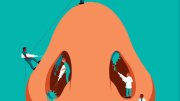This web extra supplements "Untangling the Brain," an article in the May-June 2009 issue of Harvard Magazine.
A fruit-fly maggot navigates its environment as it searches for food. The
simple behavior of the larva as it responds to stimuli can be recorded,
analyzed, and quantified, providing an opportunity to describe the precise
relationship between behavior and activity in neurons.
C. elegans roundworms navigate a temperature gradient from warm (right side of the plate) to cold (left side of the plate). Worms acclimate to the specific temperatures at which they are grown; when exposed to higher temperatures, the worms will move toward the temperature they are accustomed to. By quantifying the trajectories of these movements, shown in green, Aravinthan Samuel's lab is uncovering the basis of this behavioral strategy: how a sensory response hard-wired in the worms' neural circuits is transformed into an observable behavior.
Videos courtesy of Aravinthan Samuel








